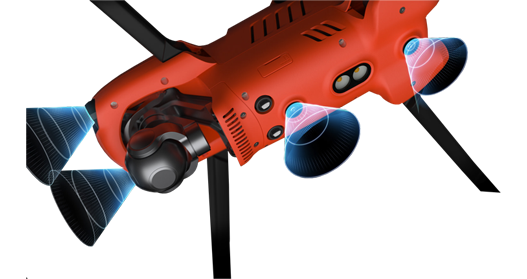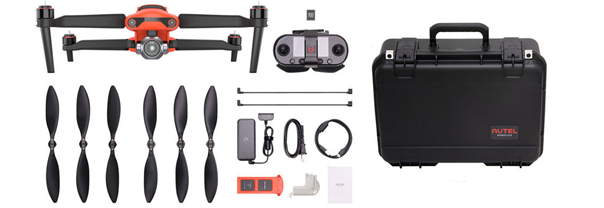Autel Evo 2 6K Rugged Bundle Review
The Autel EVO 2 is now a mature drone that has appeared in multiple guises and many forms. The version I have had to test is the Autel EVO II 6K Rugged Bundle.
First impressions are good, the case is robust and the catches look like they will stand up to some punishment.
I am not 100% convinced it will survive being run over by a car (as I had the unfortunate experience of with my own Drone) however, for your average drop or travel there should be no issues.

Remember with LIPO batteries for air travel the limit per battery is 100Wh and they must be switched off and secured for travel. The Autel EVO II has 7100mah batteries which is the equivalent of 82Wh, therefore can be taken as hand luggage on a passenger airliner.
The UAS itself is robustly built and feels somewhat more bulky than a DJI Mavic 2 Pro with a much simpler fold. It does fit comfortably into the case with the propellors attached though significantly reducing launch time.
The bright orange colour is a little bit of a love hate style relationship you either love it or you hate it, however it definitely does make the UAS a little easier to see against some backgrounds. Flying visually at distances where you will be able to see the UAS the colour becomes less significant.
The controller is comfortable to grip and the sticks feel comfortable for pinch or thumb flyers, however, the phone holder feels slightly flimsy and may require you to be careful. The screen is bright and clear with basic information such as UAS and Controller battery life and connection status. The only gripe I have with it is the position and construction of the antennae on the back. They are simply too flimsy a connection and run the risk of being broken off with repeated use.

On to flying. One great thing about the Evo II it is quiet. I noticed this from the moment the propellors started to spin. The propellors have quite a wide chord at their largest point this definitely appears to reduce noise levels in operation.
A manual take off can be flown by using the sticks to corner to start the motors. The obstacle avoidance in this mode activates quickly and gives colour coded and audible warnings that are clear and attention grabbing.
One thing I noticed that in light wind conditions the UAS is capable of a very stable hover on the days I flew this UAS I didn’t get any stronger winds to push its wind tolerance but there seems to be plenty of excess power available for position holding.
Manual flight is smooth and stable but the flight controller seems to dislike multiple control inputs and more extreme body angles or angles of attack appeared to engage the Obstacle avoidance or an attitude lock protection although this may have been a firmware issue with the specific UAS I had. The obstacle avoidance appears to work effectively when presented with immovable objects and the EVO II will not let you fly into it provided you approach at a reasonable speed in the correct mode.
With regard to the 6K camera and gimbal they appear to be robust and accurate, and the pictures taken with the camera are impressive. When processed through software the internal camera parameters are detected and produce a good quality visualisation. The UAS has a number of features content creators may find important such as 10-bit A log colour profile and 4x lossless zoom and defogging mode. The 6K camera has a 20MP 1 inch sensor and an adjustable aperture from F2.8-F11. For Night Shooting you can shoot in 6K up to ISO 6400.

Dual core object detection system with 12 cameras allows omnidirectional sensing of up to 64 objects tracking and computer vision. This is quickly becoming the minimum standard of computer vision for UAS Operations and future developments in this field is what will allow ultimately for regulatory change to allow BVLOS or Beyond Visual Line of Sight flight. The Evo II is capable of upto 72kph in sport mode but this is not a UAS designed for extreme flying and realistically most user will use it in slower flight modes the majority of the time. Sport mode is really useful for if you get caught out with stronger than expected winds and need to get back to your take off point though something Mavic mini users will remember well!

New updates to the AUTEL Evo II Ecosystem have included RTK modules allowing for greater accuracy in all axes allowing for accuracy down to 3-5cm. Interesting features such as Photo Replication and a new Thermal Camera have definitely added much greater versatility to the platform. Autel’s new smart controller will allow stand alone operations without an internet connection which is a must for many enterprise users with stringent corporate data security requirements. It has an ultra-bright screen and 128gb of internal storage coupled with an 8-core processor allowing the controller to play 4K 60FPS H.265 footage. The smart controller comes with HDMI, USB A and USB C ports for livestreaming with 4g/5g networks. Coupled with 4.5 hour of continuous use and a fast charge time of 2
hours it’s a welcome addition to the EVO II ecosystem.
Output wise I have taken a selection of images and maps with the Autel EVO II and the first thing I noticed is the auto exposure tends to be over exposed. This means that out of the box the camera will require manual modes to generate its best images.

The colours are vibrant and images detailed and on the comparison data sets it clearly showed a good level of internal camera accuracy particularly on line features such as buildings roofs.
On larger datasets flown with the onboard mission planning software the camera tended again to automatically overexpose and as such the sunlight definitely affected image quality so ND filters could definitely be required.
Greater support is definitely needed and Autel are most certainly a really interesting player in the market for pro-sumer and enterprise UAS. The EVO II represents true competition to the Mavic 2 Pro for a number of its use cases and increased interest from content creators due to the high-quality camera’s available on it.
With the advent of the EVO II Lite and Nano Autel will have a full selection of UAS/Drones from entry level to Enterprise and will firmly be joining what could be classed as the big 3, DJI, Parrot and Autel.
The DroneSpace is growing fast and with a whole host of new products slated for release keep an eye on your emails and our socials for new announcements, reviews and recommendations.